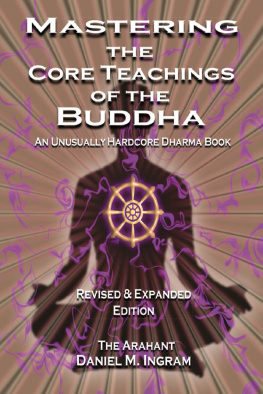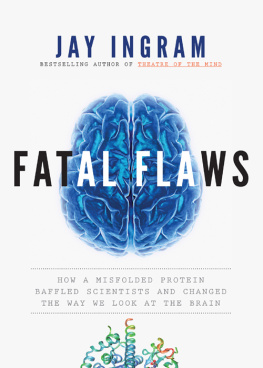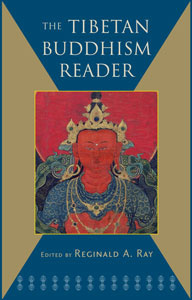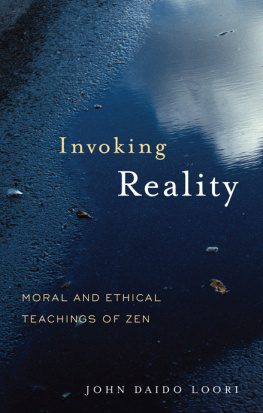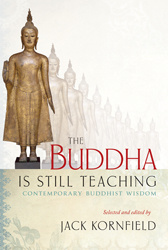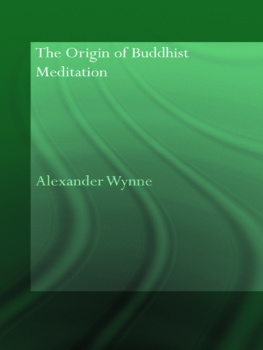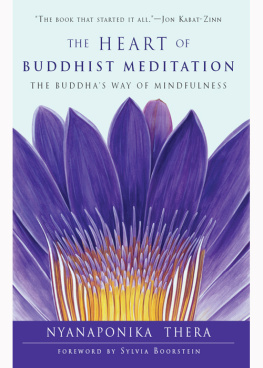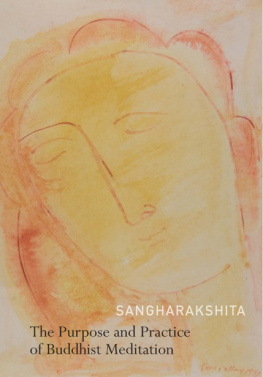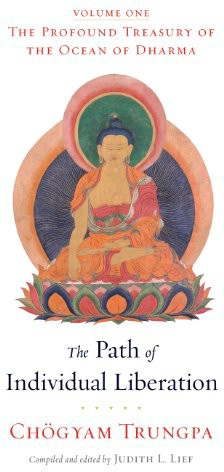Ingram - Mastering the core teachings of the Buddha: an unusually hardcore dharma book
Here you can read online Ingram - Mastering the core teachings of the Buddha: an unusually hardcore dharma book full text of the book (entire story) in english for free. Download pdf and epub, get meaning, cover and reviews about this ebook. City: London, year: 2018, publisher: Aeon Books Ltd, genre: Religion. Description of the work, (preface) as well as reviews are available. Best literature library LitArk.com created for fans of good reading and offers a wide selection of genres:
Romance novel
Science fiction
Adventure
Detective
Science
History
Home and family
Prose
Art
Politics
Computer
Non-fiction
Religion
Business
Children
Humor
Choose a favorite category and find really read worthwhile books. Enjoy immersion in the world of imagination, feel the emotions of the characters or learn something new for yourself, make an fascinating discovery.
Mastering the core teachings of the Buddha: an unusually hardcore dharma book: summary, description and annotation
We offer to read an annotation, description, summary or preface (depends on what the author of the book "Mastering the core teachings of the Buddha: an unusually hardcore dharma book" wrote himself). If you haven't found the necessary information about the book — write in the comments, we will try to find it.
Mastering the core teachings of the Buddha: an unusually hardcore dharma book — read online for free the complete book (whole text) full work
Below is the text of the book, divided by pages. System saving the place of the last page read, allows you to conveniently read the book "Mastering the core teachings of the Buddha: an unusually hardcore dharma book" online for free, without having to search again every time where you left off. Put a bookmark, and you can go to the page where you finished reading at any time.
Font size:
Interval:
Bookmark:
The causal vehicle of the paramitas
Is to gradually attain the paths and bhumis.
On the path of fruition, you should still regard
The practice of unified emptiness and compassion as the basis of the path.
The Light of Wisdom,
Root text by Padmasambhava, Commentary by Jamgon Kongtrul the Great
It must always be remembered that the Buddha way can provide relief from suffering only for those who actually practice.
Mahasi Sayadaw, Agga Maha Pandita
All is mutability, and thus your three hundred terces has fluctuated to three.
Cugel the Clever, The Eyes of the Overworld, by Jack Vance
I f you have not yet read the Foreword and Warning, please do so now. The Buddhist path has often been called a spiritual path, and this use of religious language can be very inspiring for some people. The Buddhist path can also be thought of in terms of a scientific experiment, a set of exercises that the Buddha and his followers have claimed lead to very specific, reproducible, verifiable effects, which are deemed not just worthwhile but liberative. Using this sort of practical, more scientifically oriented language can also be very inspiring for some people. However, as science doesn't often provide explicit emphases on the meaning and relevance of its findings to living humans with hearts and minds, language and concepts that can bridge that gap are often useful.
To inspire a broader audience, I will use both spiritual and practical language when discussing some of the elements concerning the Buddhist path. My preference, however, is generally for the practical language. You could throw out many of the religious trappings of the Buddhist path and still have a set of basic practices that lead to the expected effects. You could also keep all the religious trappings, do the basic practices, and produce the same results, assuming of course that you had the extra time and resources necessary to do both. That said, sorting out which elements are disposable and which are vital for getting the experiment to work is not always straightforward. Some reformative movements can easily go too far when their proponents attempt to remove all elements that don't fit with their current cultural preferences, aesthetics, and biases. So, it will be for you, me, and our fellow practitioners and adventurers to help sort this out by our own practice.
In this same pragmatic vein, there has arisen a global movement, inspired by numerous things and promoted by many people, now often referred to as the Pragmatic Dharma movementwhich I hope one day will be called something more welcoming of those allergic to words such as dharma. This movement can be characterized as embracing a worldview that includes the following ideas:
We can improve the way our minds function and the way they perceive and process reality, in numerous skillful ways.
What works is key. Specifically: it doesn't matter at all where you draw useful things from if they are effective, meaning that they provide the specific benefits sought.
Innovating by extracting key useful elements from various traditions, and combining things to come up with something that works for you is encouraged, as is pursuing traditional goals in traditional ways, as long as the approach works.
This book follows this general approach while refraining from being dismissive of elements of great value from the old traditions.
contains some traditional lists that were taught by the Buddha and relate directly to spiritual training. They make important and practical points in very concise ways. These teachings were presented succinctly on purpose so that people could remember them and use them. It is their very simplicity that makes them so practical and down-to-earth.
However, I am going to take these very condensed teachings and go on and on about them. It turns out that the Buddha sometimes made things so simple that we, 2,500+ years later, are left wondering what he was talking about and how to apply his teachings to our lives. Still, it is amazing that his teachings are still so relevant to our lives today. These teachings are designed to help people get in touch with their reality in some way that makes a difference. They can also help people avoid some of the common pitfalls on the spiritual path and in life in general, some of which I will talk about later.
The Buddha's teachings are also designed to help people develop along some of the nearly infinite axes of development. By axes of development, I mean all the ways we can improve our mind, body, and world. Since this is an endless undertaking, in this book we will focus on a relatively few very specific ones. As the book goes along, I will introduce various things we can practice, experience, gain insight into, develop, and modify that make a positive difference.
Chapter one, The Three Trainings, introduces morality, concentration, and wisdom (see also The Long Discourses of the Buddha, or the Digha Nikaya, sutta 10, usually referred to as DN 10). These three trainings encompass the sum of the Buddhist path. Thus, as is traditional and for good reason, they will be used as the conceptual framework for this book. The three trainings involve skills that we consciously and explicitly try to master. Each training has its own specific set of premises, goals, practices, and standards of mastery for those practices. These are different from each other, and problems can arise if we conflate the premises of one training when pursuing the others. Each training also has its common pitfalls, limitations, and shadow sides, which are rarely made clear, and failure to do so has caused much confusion.
Thus, I will do my best to make them clear, particularly in focused on the basic framework and practices that make the whole thing possible in the first place.
While I think that each part of this book contributes to the whole, there are reasons you may want to skip to certain sections first and fill in the rest later. For instance, if you are having is for you. If you just want to hear my take on awakening, then Models of the Stages of Awakening might be a good place to start. That said, skipping sections is likely to lead to misunderstandings, as plenty of sections that are not close to each other are yet designed to counter excesses that could arise from some other section being read on its own.
I struggled for a long time over whether to present at the beginning or at the end of the book the maps that detail what these practices lead to. I have included them at the end, but you might be the sort who wants to see them first, and if so firstly you should read the chapter called The Three Characteristics and then skip to .
T he original Pali word for this training is sila, which I am translating as morality. People translate it in various ways. Regardless of the word we choose, it is likely to resonate for people both positively and negatively. If the word morality bothers you due to the associations it suggests, look at the assumptions, agendas, and practices of this training and come up with your own word for it. I don't think that it is so important what we call it. I do, however, think that we should give careful attention to trying to live it.
From my perspective, training in morality has as its domain all the physical, verbal, and mental behaviors belonging to every single aspect of life that is not explicitly meditative. When we are trying to live a good life in the conventional sense, we are working on training in morality. When we are trying to work on improving our physical, emotional, and mental health, we are training in morality. When we philosophize, we are training in morality. When we exercise, we are training in morality. When we are taking care of others or ourselves, we are training in morality. When we try to guard the environment by not misusing or wasting resources, reform corrupt governments, or make this world a better place for everyone, we are training in morality. When we commit to a non-harming and benevolent livelihood, build a healthy marriage, raise healthy children, or shave our heads and move to a remote place to dedicate ourselves to intensive spiritual practice, we are training in morality. Whatever we do in the ordinary world that we think will be of some benefit to others and ourselves is an aspect of working on this first training.
Font size:
Interval:
Bookmark:
Similar books «Mastering the core teachings of the Buddha: an unusually hardcore dharma book»
Look at similar books to Mastering the core teachings of the Buddha: an unusually hardcore dharma book. We have selected literature similar in name and meaning in the hope of providing readers with more options to find new, interesting, not yet read works.
Discussion, reviews of the book Mastering the core teachings of the Buddha: an unusually hardcore dharma book and just readers' own opinions. Leave your comments, write what you think about the work, its meaning or the main characters. Specify what exactly you liked and what you didn't like, and why you think so.

